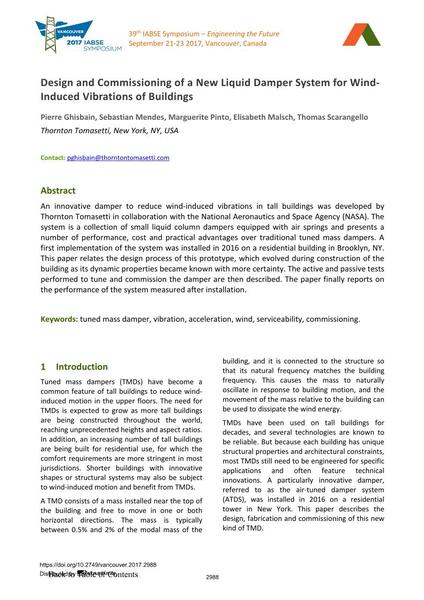Design and Commissioning of a New Liquid Damper System for Wind- Induced Vibrations of Buildings

|
|
|||||||||||
Bibliographic Details
| Author(s): |
Pierre Ghisbain
(Thornton Tomasetti, New York, NY, USA)
Sebastian Mendes (Thornton Tomasetti, New York, NY, USA) Marguerite Pinto (Thornton Tomasetti, New York, NY, USA) Elisabeth Malsch (Thornton Tomasetti, New York, NY, USA) Thomas Scarangello (Thornton Tomasetti, New York, NY, USA) |
||||
|---|---|---|---|---|---|
| Medium: | conference paper | ||||
| Language(s): | English | ||||
| Conference: | IABSE Symposium: Engineering the Future, Vancouver, Canada, 21-23 September 2017 | ||||
| Published in: | IABSE Symposium Vancouver 2017 | ||||
|
|||||
| Page(s): | 2988-2995 | ||||
| Total no. of pages: | 8 | ||||
| Year: | 2017 | ||||
| DOI: | 10.2749/vancouver.2017.2988 | ||||
| Abstract: |
An innovative damper to reduce wind-induced vibrations in tall buildings was developed by Thornton Tomasetti in collaboration with the National Aeronautics and Space Agency (NASA). The system is a collection of small liquid column dampers equipped with air springs and presents a number of performance, cost and practical advantages over traditional tuned mass dampers. A first implementation of the system was installed in 2016 on a residential building in Brooklyn, NY. This paper relates the design process of this prototype, which evolved during construction of the building as its dynamic properties became known with more certainty. The active and passive tests performed to tune and commission the damper are then described. The paper finally reports on the performance of the system measured after installation. |
||||
| Keywords: |
wind acceleration serviceability vibration tuned mass damper commissioning
|
||||
